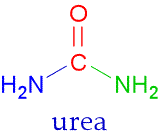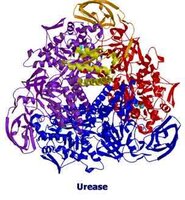Lisa_Perry75
Member
I was looking for chemical structures to show why the percentage of N changes and found this:-
http://bcn.boulder.co.us/basin/data/BACT/info/NO3+NO2.html
It is a good page with useful information on urea and ammonia. I might add that just because urea has more N %age wise it does not mean it will all be available for the plants. From what I can gather on that web page urea breaks down into ammonia and then oxidises to nitrate.
Urea

Ammonium (ammonia has 3 hydrogens)

Nitrate

And just to blow your minds I thought I'd add the structure of urease, just cos its beautifiul... I'm off to look at the structure in more detail!

http://bcn.boulder.co.us/basin/data/BACT/info/NO3+NO2.html
It is a good page with useful information on urea and ammonia. I might add that just because urea has more N %age wise it does not mean it will all be available for the plants. From what I can gather on that web page urea breaks down into ammonia and then oxidises to nitrate.
Urea

Ammonium (ammonia has 3 hydrogens)

Nitrate

And just to blow your minds I thought I'd add the structure of urease, just cos its beautifiul... I'm off to look at the structure in more detail!



 So my question is, if urease is so abundant then it follows that Ni must also be abundant, but how?? We don't dose this so I'm even more dumbfounded. Are there different "species" of urease which use different, perhaps more abundant metals at the binding site?
So my question is, if urease is so abundant then it follows that Ni must also be abundant, but how?? We don't dose this so I'm even more dumbfounded. Are there different "species" of urease which use different, perhaps more abundant metals at the binding site?